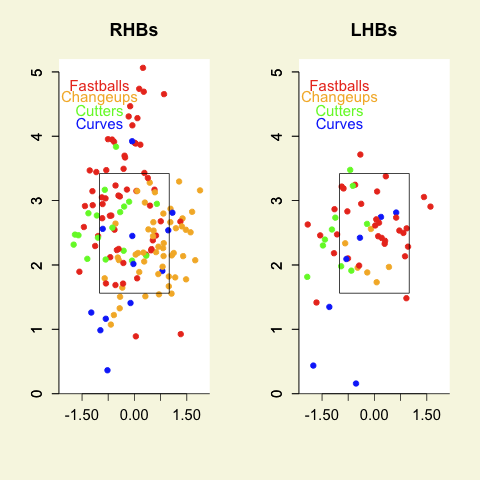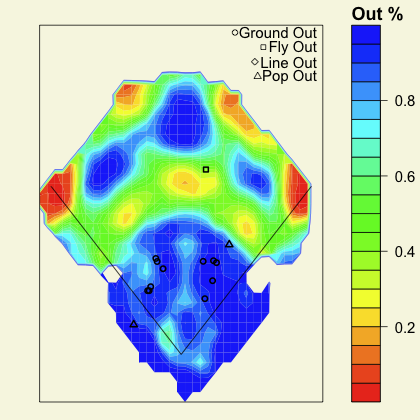Yesterday, I took a look at the two Mark DeRosa trades that Cleveland was involved in, both of which occurred within the last year. As a result, it got me thinking about the two Matt Holliday trades that also both occurred in roughly the same time period (Both DeRosa and Holliday oddly ended up with St. Louis). I was curious to see if Oakland came out on the plus side of both Holliday deals or not.
Dave Cameron and Erik Manning have both done a nice job of dissecting the Holliday trade to St. Louis, so I am not going to dwell too deeply on the trade itself. For those of you who don’t know by now, though, the Oakland Athletics received 3B/1B Brett Wallace, OF Shane Peterson, and RHP Clayton Mortensen. Wallace was St. Louis’ first-round draft pick in 2008 (13th overall), while Peterson (59th in ’08) and Mortensen (36th in ’07) were also highly regarded in college. All three players have seen their values increase since signing their initial pro contracts with the Cardinals organization.
Back on Nov. 10, 2008, Oakland general manager Billy Beane shocked baseball by acquiring Holliday from Colorado. The move was especially curious because Oakland was expected to be in rebuilding mode in 2009 and money is always an issue with the organization (The outfielder had a $13.5 million contract for 2009). But Beane obviously saw a chance to buy low (in his eyes) on a talented outfielder who could help the club contend sooner than expected in a weak American League West division. At worst, the A’s would end up with two high draft picks as compensation when Holliday headed for greener pastures as a free agent at the end of the ’09 season.
In exchange for Holliday, Oakland sent deposed closer Huston Street, left-handed starter Greg Smith, and the talented-but-frustrating young outfielder Carlos Gonzalez to Colorado. Street has had a resurgence in the National League after seeing his numbers decline in his fourth season with Oakland. In 2008, he posted a 3.47 FIP. Street allowed just 58 hits in 70 innings of work, but his walk rate increased more than one walk per nine innings over his career average to 3.47 BB/9. His strikeout rate also dropped from 11.34 in 2007 to 8.87 K/9 in 2008 (although this was a number closer to his rates in 05-06).
In Colorado in ’09, batters are hitting just .195 against the 25-year-old right-hander, which is the lowest batting-average-against that Street has posted since his rookie year in ’05 (.194 average). His strikeout rate is up to 10.20 K/9, while his walk rate is back down to 2.13 BB/9. Street’s line-drive rate is also down about three percent. His fastball is almost 2 mph harder than it was in 2007-08.
Smith, meanwhile, has had a terrible season filled with inconsistencies and injuries. After making 32 starts and pitching 190.1 innings in his rookie season for Oakland in 2008, the left-hander has yet to appear in a big-league game this year. The former sixth-round draft pick (by Arizona) has made just five triple-A starts, while also appearing in both high-A and double-A while on rehab. In his five triple-A starts, Smith has allowed 20 hits and eight walks in 23 innings of work. He also has a 5.50 FIP and has allowed four homers. Even as his rather successful 2008 campaign came to a close, a lot of baseball watchers were crying, “Fluke!”
Still only 23, Gonzalez has spent most of the 2009 season in triple-A after spending the majority of ’08 in the Majors with Oakland, where he hit a disappointing .242/.273/.361 in 302 at-bats. This year, the left-handed hitter has batted .339/.418/.630 with 10 homers in 192 at-bats. Recently recalled to Colorado, he is hitting .225/.288/.373 with one homer and seven steals in 102 at-bats. Gonzalez’ poor approach at the plate (and lack of patience) has played a large part in his weak MLB numbers.
Colorado really did not get as much value for Holliday as it likely had hoped. The organization received a solid, young closer with a lot of experience, a future left-handed reliever, and a toolsy young outfielder that is looking more Delmon Young than Justin Upton. With that said, comparing the three players that Oakland received for Holliday and the three players that the organization gave up for Holliday, it looks pretty even at this point especially when you consider how Street’s stability in the bullpen has helped Colorado remain in the playoff hunt.
Wallace, though, has the potential to significantly overshadow the loss of Street if he can live up to his potential, but that could take a few years. Even so, you have to figure that a lot of organizations would trade Street for Wallace, straight up. Trading Smith and Gonzalez for Peterson and Mortensen is a bit of a toss up, and really depends on how much you believe in Gonzalez. If he reaches his potential, he could be an impact player. Both Peterson and Mortensen look like complementary parts, but they should both end up being more valuable than Smith.
In the end, it’s hard to say if Oakland came out on the winning end of the two Holliday deals or not. In the long run, though, my gut says that they did.



